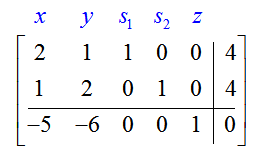I am creating a problem where a student sets up an initial simplex tableau and I am having trouble getting the correct formatting answer matrix. In particular, I want to put column labels on top of a 3 x 6 grid filled with answer blanks. Ideally, it'd look like (image taken from https://math-faq.com/wp/chapter-4/section-4-3/section-4-3-question-3/):

but with the numbers replaced by answer blanks for students to enter and the variables do not need to be blue. My attempt at this is below. However, I do not like it because I am manually adding space for the labels. Any suggestions are greatly appreciated!
DOCUMENT();
loadMacros(
"PGstandard.pl",
"MathObjects.pl",
"PGML.pl",
"niceTables.pl",
"PGmatrixmacros.pl",
"PGchoicemacros.pl",
);
TEXT(beginproblem());
Context("Numeric");
Context()->variables->add(y=>"Real");
Context()->flags->set(tolerance => 0, tolType => "absolute");
Context()->noreduce('(-x)-y','(-x)+y');
@n = (1..9)[shuffle(9)];
$Px = non_zero_random(2,29);
$Py = non_zero_random(2,29);
$drhs1 = random(2,20);
$drhs2 = random(2,20);
$dlhs1 = Formula("$n[0] x + $n[1] y")->reduce;
$dlhs2 = Formula("$n[2] x + $n[3] y")->reduce;
Context()->texStrings;
$LP = DataTable(
[
["Objective:", "\(\quad\) Maximize \(P = $Px x + $Py y\)"],
["Subject to:", "\(\quad\) \($dlhs1 \le $drhs1 \)"],
["", "\(\quad\) \($dlhs2 \le $drhs2 \)"],,
["", "\(\quad\) \(x \ge 0\), \(y \ge 0\)"],
],
center => 0,
align => 'lc',
);
Context()->normalStrings;
$dmat1 = DataTable(
[
['\(\qquad\quad\quad\quad\quad x \)',
'\(\qquad\qquad\qquad\qquad\qquad y\)',
'\(\qquad\qquad\qquad\qquad\quad\quad s_1\)',
'\(\qquad\qquad\qquad\qquad\quad\quad s_2\)',
'\(\qquad\qquad\qquad\qquad\quad\quad P\)',
'\(\qquad\qquad\qquad\qquad \mbox{constant}\) ']
],
center => 0,
align => 'c c c c c c',
);
$dlbrack = "\(\begin{array}{c} \\\ \\\ \\\ \end{array} \left[ \begin{array}{c} \\\ \\\ \\\ \\\ \\\ \end{array}\right. \)";
$drbrack = "\(\begin{array}{c} \\\ \\\ \\\ \end{array} \left. \begin{array}{c} \\\ \\\ \\\ \\\ \\\ \end{array}\right] \)";
$dmat2 = mbox($dlbrack,DataTable(
[
[ans_rule(10),ans_rule(10),ans_rule(10),ans_rule(10),ans_rule(10),ans_rule(10)],
[ans_rule(10),ans_rule(10),ans_rule(10),ans_rule(10),ans_rule(10),[ans_rule(10),midrule=>1]],
[ans_rule(10),ans_rule(10),ans_rule(10),ans_rule(10),ans_rule(10),ans_rule(10)]
],
center => 0,
align => 'c c c c c | c',
),$drbrack);
$dmat = DataTable(
[
[$dmat1],[$dmat2]
],
center => 0,
align => 'c',
);
BEGIN_PGML
Set up the initial simplex tableau corresponding to the following linear program.
[@ $LP @]***
[@ mbox($dmat) @]***
END_PGML
ANS(Compute($n[0])->cmp());
ANS(Compute($n[1])->cmp());
ANS(Compute(1)->cmp());
ANS(Compute(0)->cmp());
ANS(Compute(0)->cmp());
ANS(Compute($drhs1)->cmp());
ANS(Compute($n[2])->cmp());
ANS(Compute($n[3])->cmp());
ANS(Compute(0)->cmp());
ANS(Compute(1)->cmp());
ANS(Compute(0)->cmp());
ANS(Compute($drhs2)->cmp());
ANS(Compute(-$Px)->cmp());
ANS(Compute(-$Py)->cmp());
ANS(Compute(0)->cmp());
ANS(Compute(0)->cmp());
ANS(Compute(1)->cmp());
ANS(Compute(0)->cmp());
ENDDOCUMENT();